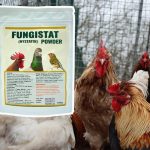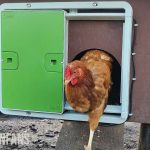Infectious Coryza in Chickens


Infectious coryza is a bacterial disease that most poultry owners will face once in their life. It can suddenly show up and kill many of your birds. Luckily there are antibiotics and vaccines on the market.
Let’s look at coryza and what you can do about it.
What is Infectious Coryza?
Infectious coryza is a widespread, highly contagious upper respiratory disease in chickens caused by the bacteria Avibacterium paragallinarum. Typical symptoms include sneezing, facial swelling, watery eyes, and difficulty breathing. Infections strike fast but can be treated with antibiotics. Chickens usually recover after 7-11 days.
The disease is a worldwide threat for chicken owners and affects chickens of all ages. Many chicken owners encounter the condition at least once in their life.
Coryza can be fatal. Mortality is generally low but can be up to 20%, where one bird in five won’t make it. However, multiple antibiotics are effective against coryza.
Symptoms of Infectious Coryza
Infectious coryza is primarily an upper respiratory disease that comes with nasal discharge and inflammation of the eyes.

Symptoms of infectious coryza are:
- difficulty breathing
- facial swelling
- nasal discharge and sneezing
- inflammation of the eye and cloudy eyes
- watery, foamy eyes with bubbles
- sometimes the eyes are completely shut down
- gurgling and rattling sounds in the windpipe
- head-shaking
- diarrhea, reduced food intake
- decrease in egg production
Sometimes the manifestation can be relatively mild. In those cases, chickens don’t show many of the symptoms apart from nasal discharge and general lethargy.
While rare, infectious coryza can also cause chickens to walk backward with giant steps.
Diseases with similar symptoms
The symptoms are very similar to symptoms of other respiratory diseases, like:
- Chronic Respiratory Disease – a similar bacterial infection, also known as mycoplasmosis
- Infectious Bronchitis – a contagious disease caused by a variety of coronavirus strains
- Infectious Laryngotracheitis – a viral infection with the herpes virus
- Fowl Cholera – a bacterial disease that turns chicken combs purple
- Newcastle Disease – a viral infection with the Newcastle disease virus
- Avian influenza – a viral infection with the influenza virus
- Vitamin A Deficiency – a shortage of vitamin A
Since all these diseases share similar clinical signs, only a veterinarian can do a correct diagnosis.
Avibacterium paragallinarum
To validate for coryza, a vet will execute a bacteriological examination on the rod-shaped Avibacterium paragallinarum bacteria.

Avibacterium paragallinarum is a bacterium from the Pasteurella family. Another member of that family is Pasteurella Multocida, the causing agent of Fowl Cholera. Fowl Cholera causes blood poisoning and watery green or yellow diarrhea.
Treatment
There are several antibiotics available that are effective against A. paragallinarum. The sooner you start medication, the bigger your chances of suppressing the bacteria. If medication is not instantly available, add antibiotic supplements to the chicken’s drinking water.
In uncomplicated cases, chickens recover in 7 to 11 days. In complicated cases, it can take up to a month.
Treatment always goes hand-in-hand with preventative measures to reduce infection rates. It’s essential to take appropriate biosecurity measures.
With severe infections and outbreaks, some poultry keepers choose to replace (part of) their flock with new birds. If culling is the method of choice, ensure the coryza-free birds are never mixed with any infected chickens. Replacement pullets can be treated with antibiotics or vaccines to prevent new infections.
Completing the antibiotic cycles is essential. In several cases, coryza infections reappeared when treatment was stopped prematurely.
Vaccination
Vaccination is the best way to prevent infections in places with a high prevalence of infectious coryza. The advantage of the available vaccines is that they protect against multiple bacterial strains. However, new V-factor Coryza-variants emerged in South America and South Africa, showing unusual clinical manifestations and vaccine failures.
Vaccinated birds can still get sick but will show only mild symptoms.
Transmission
Transmission typically occurs via direct contact or by contamination of the drinking water. However, the bacteria can also be transmitted via droplets in the air. Coryza infections do not transfer via the eggs, and infectious coryza is not contagious to humans.
Coryza affects birds of all ages but tends to be more common in older chickens. The incubation period is short: 24-72 hours. Chickens can already show symptoms the day after infection.
Summary
Infectious coryza is a respiratory disease in chickens caused by a bacterial infection. Infected birds have difficulties breathing, nasal discharge, and watery eyes. The onset is usually very sudden, and it’s important to start antibiotics as soon as possible.
In some cases, the symptoms can be mild, especially in vaccinated birds. However, it can be difficult to control an outbreak in severe cases. That’s why many poultry keepers choose to replace (part of) their flock in case of infection.
If you want to read more about chicken health problems, symptoms, and diseases, check out our ‘Health Page‘. You’ll find a ‘Symptom Checker‘, a complete list of ‘Chicken Behavior‘, and an overview of the most common ‘Chicken Diseases‘. Or go to ‘The Classroom‘ and find a comprehensive list of all Chicken Fans articles.

Dr. I. Crnec is a licensed veterinarian with several years of experience. She has published work on the effect of vitamin supplementation, egg-laying performances of chickens under heat-stress conditions and the effects of calcium supplementation on eggshell strength.





















